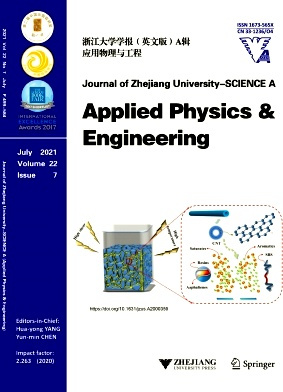Journal of Zhejiang University-Science A雜志是SCD期刊嗎?
來源:投稿網 2025-01-12 9:30:15
Journal of Zhejiang University-Science A雜志不是SCD期刊,經查詢Journal of Zhejiang University-Science A雜志不在最新的2023年SCD期刊目錄中。
科學引文數據庫(英文名:Science Citation Database,簡稱:SCD)是《中國大學評價》課題組獨立研發、擁有全部知識產權的國內引文數據庫。2023年最新版SCD《中國科學引文數據庫》來源期刊目錄已于2022年12月公布,共涉及14個大類學科2534本期刊,相較于去年2860本期刊,本次目錄變更巨大。根據學科分類如下:
| 理學:共收錄198本期刊 | 工學:共收錄405本期刊 |
| 農學:共88本期刊 | 醫學:共收錄209本期刊 |
| 哲學:共收錄52本期刊 | 經濟學:共收錄97本期刊 |
| 法學:共收錄281本期刊 | 教育學:共收錄142本期刊 |
| 文學:共收錄164本期刊 | 歷史學:共收錄70本期刊 |
| 管理學:共收錄172本期刊 | 藝術學:共收錄83本期刊 |
| 交叉學科:4本期刊 | 綜合學科:共收錄569本期刊 |
SCD相關問題
問:SCD期刊是核心期刊嗎?
SCD是一個相對綜合性的數據庫,有文科也有理科刊物,有核心(統指國內的五大主流核心)也有普刊。
問:SCD期刊好發嗎?
相較于CSSCI、CSCD等核心期刊,SCD期刊相對好發一些。但此次更新后,不少好發的刊物已經被剔除。
問:哪些人適合發SCD期刊?
在讀碩士、教職人員、科研人員等。
Journal of Zhejiang University-Science A投稿要求
Journal of Zhejiang University-Science A雜志投稿須知:I. Paper Format Requirements TOP
1、 FiguresFormat At the revision stage, authors who have created their files using a drawing or painting program such as Visio, Origin, Excel, AutoCAD, Coreldraw should provide the original files that can be edited. Authors who have created their files using a drawing or painting program should export the files to TIFF, EPS, PSD, RAW, etc. format. Matlab figures are expected to be exported to EMF or EPS format. The figure’s magnification should be expressed by scale bars.Resolution For manuscripts in the revision stage, adequate figure resolution is essential to a high-quality print and online rendering of your paper. Raster line art should carry an absolute minimum resolution of 600 dots per inch (dpi).Line width The line width should generally be no less than 0.25 pt, and in our journal, the common line width is 0.5/0.75 pt. Please note that the actual line width changes with the scale of the figure. In different software, we recommend the line width: Visio: — 03; Origin: — 1、5; Matlab: — 1、5 pt, etc.Figures must be numbered consecutively with Arabic numerals, and each figure must be placed in the text following the paragraph in which it is first mentioned. A caption giving the figure number and a brief description must be included. The caption should be understandable without reference to the text. Figures should be cited in the text using the following format: Fig. 1, Fig. 1a, Figs. 1 and 2, Figs. 1–3, or Figs. 1a–1c.There will be an extra charge for those graphics considered for publication in color. Authors are expected to use different line types to distinguish the different parts of a figure that they do not want to have published in color.。
2、 TablesTables should be set up in Word and should usually contain three horizontal lines. Do not use vertical lines. Each table must have a brief title that describes its contents. The title should be understandable without reference to the text. Details such as explanatory material, specific entries, and definitions of non-standard abbreviations should be put in table footnotes, not in the title. In setting up tables, authors should keep in mind the area of the Journal’s page (16、4 cm×22、8 cm) and the column width (8.0 cm) and should make tables conform to the limitations of these dimensions.All tables must be mentioned in the text in consecutive order and must be numbered with Arabic numbers. Tables should be cited in the text using the following format: Table 1, Tables 1 and 2, or Tables 1–。
3、3、 Variables and formulaeVariables, regardless of the context (formula, figure or table), should be in Italics (e.g., x1); if a variable represents a vector or a matrix, it should be in Italics & bold (e.g., x1). Numerals and operators should never be italicized unless they are components of a variable.Authors are encouraged to import symbols and simple equations using normal text and fonts, e.g., “α” (not “” in MathType), “?” (not “-“) for a minus.For complex formulae, use a formula editor (e.g., MathType) and define the sizes as follows:Full: 10.5 pt;Subscript/Superscript: 58%;Sub-subscript/Superscript: 42%;Symbol: 150%;Sub-symbol: 100%.。
4、 UnitsUnits should be metric and follow SI convention:M→mol/L, rpm→r/min, etc.Some units such as ppb, ppm, ?, wt%, mol% are not SI ones and need to change into SI format:ppm→10?6, ?→0.1 nm, etc.Short forms:30 minutes→30 min, 2 hours→2 h, 10 days→10 d, etc.Put a space between a numeral and its unit of measure (exceptions: no space between a number and the percent “%?”, degree “°”, angular minute “′” or angular second “″”).。
5、Text CitationThe basic form of the author-date in the text consists of the author’s last (family) name. a comma, and the year of publication of the work.Examples of text citations:One author: (Vandermeer, 1990)Two authors: (Sun and Wang, 2000; Cao and Xu, 2001)Three or more authors: (Moons et al., 1997; Schlag et al., 2000a; 2000b)。
6、 Reference List (for accepted papers)The reference list provides complete information of the author-date citation in English and lists in alphabetical order of authors’ surnames. For references with more than three authors, the first three names should be given, followed by et al. The references mentioned in the text should accord with the reference list. For a reference published other than in English, the language used should be noted at the end of the reference list, e.g., (in Chinese). The publisher and place of publication should be given for a book or proceedings.
 點擊前往雜志首頁
點擊前往雜志首頁
相關問題
- Journal of Zhejiang University-Science A是正規期刊嗎?
- Journal of Zhejiang University-Science A是什么級別的期刊?
- Journal of Zhejiang University-Science A評職稱可以嗎?
- Journal of Zhejiang University-Science A是北大核心嗎?
- Journal of Zhejiang University-Science A是科技核心嗎?
- Journal of Zhejiang University-Science A是統計源核心嗎?
- Journal of Zhejiang University-Science A是南大核心CSSCI嗎?
- Journal of Zhejiang University-Science A是CSCD期刊嗎?
- Journal of Zhejiang University-Science A是國家級期刊嗎?






